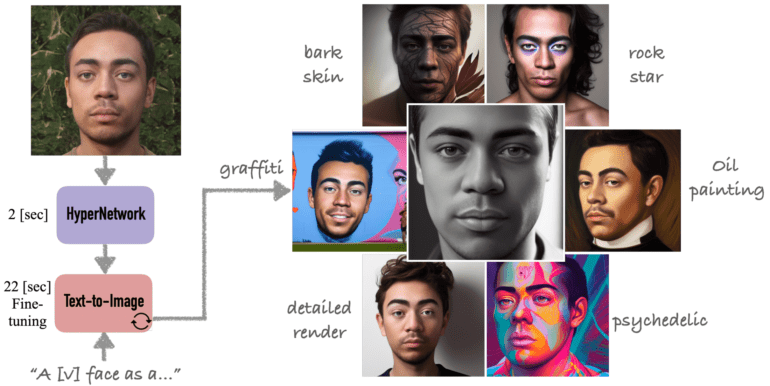TL;DR:
- Google AI researchers introduced HyperDreamBooth, an AI approach for personalized face generation.
- HyperDreamBooth efficiently generates personalized weights from a single person’s image.
- It is 25x faster than DreamBooth and 125x faster than Textual Inversion.
- The model is 10,000 times smaller than regular DreamBooth models.
- HyperDreamBooth maintains high subject fidelity and aesthetic variation.
- It utilizes a lightweight DreamBooth model and a novel HyperNetwork architecture.
- Rank-relaxed fine-tuning enhances subject fidelity in the personalized model.
Main AI News:
The realm of generative Artificial Intelligence (AI) has been capturing the spotlight as recent advancements in text-to-image (T2I) personalization continue to unveil groundbreaking possibilities. One compelling aspect within this field is the concept of personalization, which involves generating distinct individuals in various contexts and styles while preserving their core identities. Generative AI has witnessed remarkable progress in face personalization, empowering the creation of diverse, stylized portraits of specific individuals through the utilization of pre-trained diffusion models with robust style priors.
Current techniques such as DreamBooth and similar approaches have managed to excel by incorporating new subjects into the model without compromising past knowledge, while also retaining the essence and unique characteristics of each individual across a multitude of presentations. However, these methods face inherent limitations, particularly concerning the size of the model and its training speed. DreamBooth, for instance, entails fine-tuning all the weights of the UNet and Text Encoder of the diffusion model, resulting in a significantly large model size of over 1GB for stable diffusion. Additionally, the training process for Stable Diffusion can take up to 5 minutes, hindering widespread adoption and practical application.
To overcome these challenges, a team of Google Research experts has introduced HyperDreamBooth, a groundbreaking solution that harnesses the power of hypernetworks to efficiently generate a compact set of personalized weights from just a single image of a person. HyperDreamBooth’s hypernetwork expertly crafts a miniature ensemble of customized weights using only one reference image. These unique weights are then coupled with the diffusion model, undergoing rapid adjustments. The outcome is a formidable system capable of generating a person’s face in various situations and aesthetics, all while preserving intricate details and the diffusion model’s profound understanding of diverse styles and semantic alterations.
Perhaps one of HyperDreamBooth’s most remarkable achievements lies in its unprecedented speed. It operates at a staggering 25 times the pace of DreamBooth and an astonishing 125 times faster than a related technology called Textual Inversion, enabling face personalization in a mere 20 seconds. Notably, HyperDreamBooth achieves this impressive customization speed while maintaining the same degree of quality and aesthetic variation as DreamBooth. Moreover, this swift customization process requires only a single reference image, streamlining the overall workflow. In terms of model size, HyperDreamBooth also excels, boasting a personalized model that is a remarkable 10,000 times smaller than a regular DreamBooth model. This advantage not only enhances the model’s manageability but also significantly reduces storage requirements.
The team behind HyperDreamBooth has summarized their contributions as follows:
- Lightweight DreamBooth (LiDB): Introducing a personalized text-to-image model with a customized part of approximately 100KB. This achievement is realized by training the DreamBooth model within a low-dimensional weight-space generated by a random orthogonal incomplete basis within a low-rank adaptation weight space.
- Novel HyperNetwork Architecture: Leveraging the configuration of LiDB, the HyperNetwork generates tailored weights for specific subjects within a text-to-image diffusion model. This approach provides a robust directional initialization, facilitating rapid fine-tuning to achieve high subject fidelity within a few iterations. Notably, this method outperforms DreamBooth by a factor of 25 in terms of speed while delivering comparable performance.
- Rank-Relaxed Fine-Tuning: The team has introduced the technique of rank-relaxed fine-tuning, which enhances subject fidelity by relaxing the rank of a LoRA DreamBooth model during optimization. This novel approach enables the personalized model to be initialized with an initial approximation from the HyperNetwork, subsequently refining high-level subject details through rank-relaxed fine-tuning.
With the introduction of HyperDreamBooth, the landscape of generative AI personalization is set to undergo a transformative revolution. By efficiently generating personalized weights from a single image and boasting remarkable speed and model size advantages, HyperDreamBooth paves the way for widespread adoption and practical utilization in various domains.
Conclusion:
The introduction of HyperDreamBooth marks a significant advancement in the field of AI personalization. Its ability to generate personalized weights from a single image with remarkable speed and efficiency opens up new possibilities for various industries. The substantial reduction in model size makes it more manageable and reduces storage requirements, contributing to its practical application. With HyperDreamBooth’s high subject fidelity, aesthetic variation, and the potential for rapid fine-tuning, the market can expect accelerated adoption of AI-driven personalization solutions in domains such as entertainment, advertising, and virtual reality experiences.

